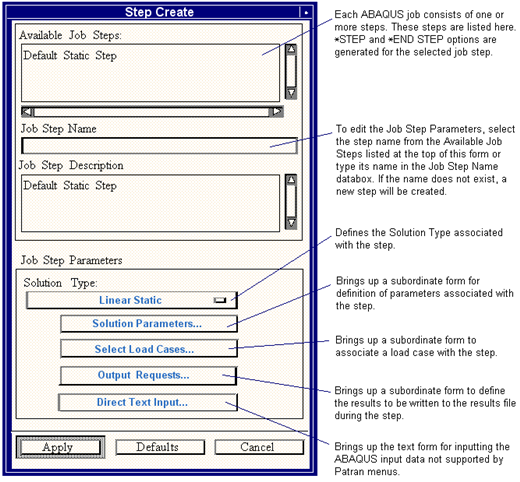

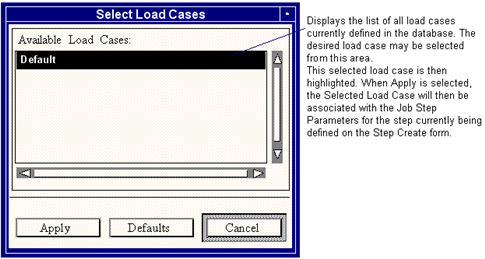
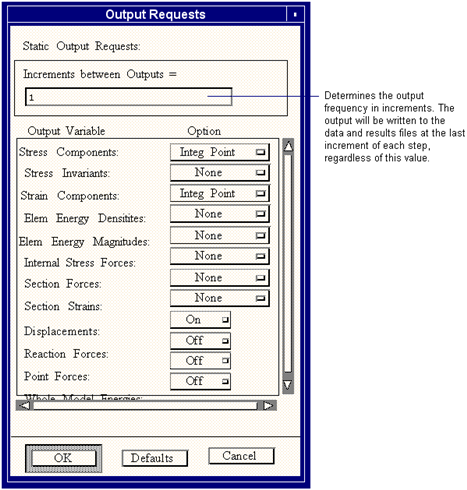
Note: | There is no checking available for invalid data. The font for the text input may vary from one system to another. A default font is specified in app_defaults/Patran file: |
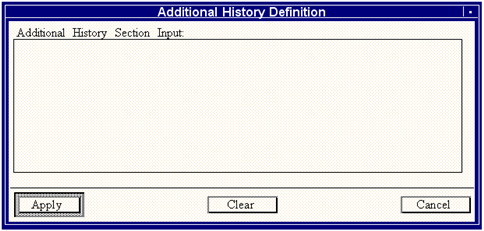
Parameter Type | Description |
Linear Static | Static stress analysis is used when inertia effects can be neglected. During a linear static step, the model’s response is defined by the linear elastic stiffness at the base state, the state of deformation and stress at the beginning of the step. For ∗HYPERELASTIC and ∗HYPERFOAM materials, the tangent elastic moduli in the base state is used. Contact conditions cannot change during the step--they remain as they are defined in the base state. |
Natural Frequency | This solution type uses eigenvalue techniques to extract the frequencies of the current system. The stiffness determined at the end of the previous step is used as the basis for the extraction, so that small vibrations of a preloaded structure can be modeled. |
Bifurcation Buckling | Eigenvalue buckling estimates are obtained. Classical eigenvalue buckling analysis (e.g., “Euler” buckling) is often used to estimate the critical (buckling) load of “stiff” structures. “Stiff” structures are those that carry their design loads primarily by axial or membrane action, rather than by bending action. Their response usually involves very little deformation prior to buckling. |
Direct Linear Transient | This solution procedure integrates all of the equations of motion through time, and is significantly more expensive than modal methods for finding dynamic response for linear systems. For linear systems, the dynamic method, using the Hilber-Hughes-Taylor operator, is unconditionally stable, meaning there is no mathematical limit on the size of the time increment that can be used to integrate a linear system. Since the procedure uses a fixed time increment, the HAFTOL parameter on the *DYNAMIC card is not required. |
Direct Steady State Dynamics | Calculates steady state response for the given range of frequencies. The damping may be created by dashpots, by “Rayleigh” damping associated with materials, and by viscoelasticity included in the material definitions. |
Modal Linear Transient | This solution type gives the response of the model as a function of time, based on a given time dependent loading. The procedure is based on using a subset of the eigenmodes of the system, which must first be extracted using the NATURAL FREQUENCY solution type.The number of modes extracted must be sufficient to model the dynamic response of the system adequately. This is a matter of judgment on the part of the user. The modal amplitudes are integrated through time and the response synthesized from these modal responses. |
Modal Steady State Dynamics | This solution type provides the response of the system when it is excited by harmonic loading at a given frequency. This procedure is usually preceded by extraction of the natural modes using the NATURAL FREQUENCY solution type, although ABAQUS also allows the response to be calculated directly from the system matrices for use in those cases where the eigenvalues cannot be extracted, such as a nonsymmetric stiffness case, or models in which the behavior is itself a function of frequency, such as frequency dependent material damping. |
Response Spectrum | This solution type provides an estimate of the peak response of a structure to steady-state dynamic motion of its fixed points (“base motion”). The method is typically used when an approximate estimate of such peak response is required for design purposes. The procedure is based on using a subset of the eigenmodes of the system, which must first be extracted using the NATURAL FREQUENCY solution type. |
Random Vibration | This solution type predicts the response of a system which is subjected to a nondeterministic continuous excitation that is expressed in a statistical sense using a power spectral density function. The procedure is based on using a subset of the eigenmodes of the system, which must first be extracted using the NATURAL FREQUENCY solution type. |
Nonlinear Static | Nonlinear static analysis requires the solution of nonlinear equilibrium equations, for which ABAQUS uses Newton’s method. Many problems involve history dependent response, so that the solution is usually obtained as a series of increments, with iteration within each increment to obtain equilibrium. For most cases, the automatic incrementation provided by ABAQUS is preferred, although direct user control is also provided for those cases where the user has experience with a particular problem. |
Nonlinear Transient Dynamic | This solution type is used when nonlinear dynamic response is being studied. Because all of the equations of motion of the system must be integrated through time, direct integration methods are generally significantly more expensive than modal methods. For most cases, the automatic incrementation provided by ABAQUS is preferred, although direct user control is also provided for those cases where the user has experience with a particular problem. |
Creep | This analysis procedure performs a transient, static, stress⁄displacement analysis. It is especially provided for the analysis of materials which are described by the ∗CREEP material form. |
Viscoelastic (Time Domain) | This is especially provided for the time domain analysis of materials which are described by the ∗VISCOELASTIC, TIME material option. The dissipative part of the material behavior is defined through a Prony series representation of the normalized shear and bulk relaxation moduli, either specified directly on the ∗VISCOELASTIC, TIME material option, determined from user input creep test data, or determined from user input relaxation test data. |
Viscoelastic (Frequency Domain) | This is especially provided for the frequency domain analysis of materials which are described by the ∗VISCOELASTIC, FREQUENCY material option, which is activated by a ∗STEADY STATE DYNAMICS, DIRECT procedure.The dissipative part of the material behavior is defined by the real and imaginary parts of the Fourier transforms of the nondimensional shear viscoelasticity parameter g and, for compressible materials, of the bulk viscoelasticity parameter k. |
Steady State Heat Transfer | This solution type is for pure heat transfer problems for which the ∗HEAT TRANSFER option is used and where the temperature field can be found without knowledge of stress and deformation of the bodies being studied. |
Transient Heat Transfer | This solution type is for pure transient heat transfer problems for which the ∗HEAT TRANSFER option is used and where the temperature field can be found without knowledge of stress and deformation of the bodies being studied. For all transient heat transfer cases, the time increments may be specified directly, or will be selected automatically based on a user prescribed maximum nodal temperature change in a step. Automatic time incrementation is generally preferred. |
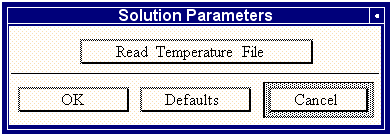
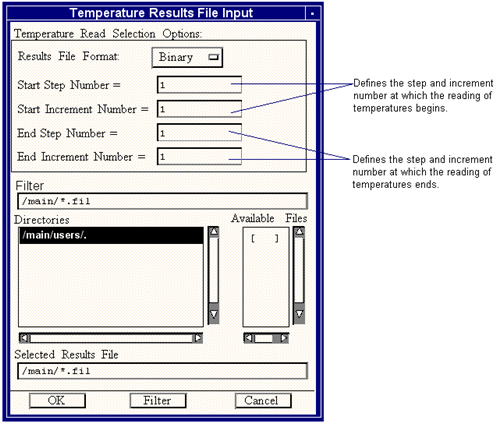
Parameter Name | Description | Output Variable Identifier |
Stress Components | The stress components output depend on the elements analyzed. For example, the truss element outputs the axial stress (S11) only, while a three-dimensional solid element outputs all six components (S11, S22, S33, S12, S13, S23). Note that ABAQUS always reports the Cauchy, or true stress, which is equal to the force per current area. For more information about element output, see Chapter 3 of the ABAQUS/Standard User’s Manual. | S11, S22, S33, S12, S13, S23 |
Stress Invariants | The stress invariants output by ABAQUS are the Mises stress, Tresca stress, Hydrostatic pressure, first principal stress, second principal stress, third principal stress, and the third stress invariant. These quantities are scalar quantities which do not vary with a change of coordinate system. For elastic analyses, the von Mises and/or the Tresca stress invariants can be monitored to ensure that the analysis remains within the assumptions of linearity. | SINV |
Strain Components | This is the total strain value for each component output. The strain components output depend on the elements analyzed, analogous to the stress components. Note that, for linear elastic analyses, the total strain is equal to the elastic strain. | E |
Elem Energy Densities | The strain energy per unit volume of each element. Plastic, creep, and viscous dissipative energy densities should not be affected by linear static analysis. | ENER |
Elem Energy Magnitudes | The strain energy of each element. Plastic, creep, and viscous dissipative energy densities should not be affected by linear static analysis. | ELEN |
Internal Stress Forces | The forces that are found at each node by summing the element stress contributions at the nodes. | NFORC |
Section Forces | Section forces are output for beam elements and include the axial force, and, as applicable, the shears, bending moments and bimoment about the local axes. These are discussed in Section 3.5.1 and Section 7.5.2 of the ABAQUS/Standard User’s Manual. For shell elements, the section forces include the direct membrane, shear, and moment forces per unit width, as applicable. These are discussed in Section 3.6 of the ABAQUS/Standard User’s Manual. | SF |
Section Strains | Section strains are output for beam elements and, as applicable, these include the axial strain, transverse shear strains, curvature changes, and twist about the local axes.These are discussed in Section 3.5.1 and Section 7.5.2 of the ABAQUS/Standard User’s Manual. For shell elements, the section strains include the direct membrane, shear, curvature changes, and twist, as applicable. These are discussed in Section 3.6 of the ABAQUS/Standard User’s Manual. | SE |
Shell Thickness | Changes in thickness for shell elements (S3RF, S4RF,SAX1, SAX2, SAXA1N, SAXA2N). | STH |
Displacements | Displacements are output at nodes and are referred to as follows: 1. x-displacement 2. y-displacement 3. z-displacement 4. Rotation about the x-axis 5. Rotation about the y-axis 6. Rotation about the z-axis Except for axisymmetric elements, where the displacement and rotation degrees-of-freedom are: 1. r-displacement 2. z-displacement 3. Rotation in the r-z plane Here x, y, z, and r are global directions unless a coordinate transformation is used at the node. Note that the warping degree-of-freedom, the seventh displacement component of an open section beam element, is not supported by Patran at this time. | U |
Reaction Forces | The forces at the nodes which are constrained and therefore, resist changes in the system. The direction convention is the same as that for nodal output. | RF |
Point Forces | The forces at the nodes resulting from the imposed loads (e.g., the force at a node resulting from pressure distributions on adjacent elements). | CF |
Whole Model Energies | The summation of all the energy of the model. The kinetic, recoverable (elastic) strain, plastic dissipation, creep dissipation, and viscous dissipation are reported. | ALLEN |
Element Mass Matrix | Mass matrices output. | |
Element Stiffness Matrix | Stiffness matrices output. |
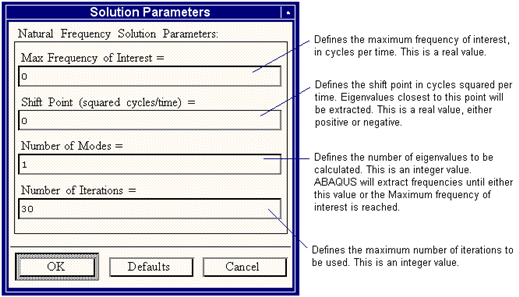
Parameter Name | Description | Output Variable Identifier |
Stress Components | The stress components output depend on the elements analyzed. For example, the truss element outputs the axial stress (S11) only, while a three-dimensional solid element outputs all six components (S11, S22, S33, S12, S13, S23). Note that ABAQUS always reports the Cauchy, or true stress, which is equal to the force per current area. For more information about element output, see Chapter 3 of the ABAQUS/Standard User’s Manual. | S11, S22, S33, S12, S13, S23 |
Stress Invariants | The stress invariants output by ABAQUS are the Mises stress, Tresca stress, Hydrostatic pressure, First principal stress, second principal stress, third principal stress, and the third stress invariant. These quantities are scalar quantities which do not vary with a change of coordinate system. | SINV |
Strain Components | This is the total strain value for each component output. The strain components output depend on the elements analyzed, analogous to the stress components. Note that, for linear elastic analyses, the total strain is equal to the elastic strain. | E |
Section Forces | Section forces are output for beam elements and include the axial force, and, as applicable, the shears, bending moments and bimoment about the local axes. These are discussed in Section 3.5.1 and Section 7.5.2 of the ABAQUS/Standard User’s Manual. For shell elements, the section forces include the direct membrane, shear, and moment forces per unit width, as applicable. These are discussed in Section 3.6 of the ABAQUS/Standard User’s Manual. | SF |
Section Strains | Section strains are output for beam elements and, as applicable, these include the axial strain, transverse shear strains, curvature changes, and twist about the local axes.These are discussed in Section 3.5.1 and Section 7.5.2 of the ABAQUS/Standard User’s Manual. For shell elements, the section strains include the direct membrane, shear, curvature changes, and twist, as applicable. These are discussed in Section 3.6 of the ABAQUS/Standard User’s Manual. | SE |
Shell Thickness | Changes in thickness for shell elements (S3RF, S4RF,SAX1, SAX2, SAXA1N, SAXA2N). | STH |
Displacements | Displacements are output at nodes and are referred to as follows: 1. x-displacement 2. y-displacement 3. z-displacement 4. Rotation about the x-axis 5. Rotation about the y-axis 6. Rotation about the z-axis Except for axisymmetric elements, where the displacement and rotation degrees-of-freedom are: 1. r-displacement 2. z-displacement 3. Rotation in the r-z plane Here x, y, z, and r are global directions unless a coordinate transformation is used at the node. Note that the warping degree-of-freedom, the seventh displacement component of an open section beam element, is not supported by Patran at this time. | U |
Reaction Forces | The forces at the nodes which are constrained and therefore, resist changes in the system. The direction convention is the same as that for nodal output. | RF |
Element Mass Matrix | Mass matrices output. | |
Element Stiffness Matrix | Stiffness matrices output. |
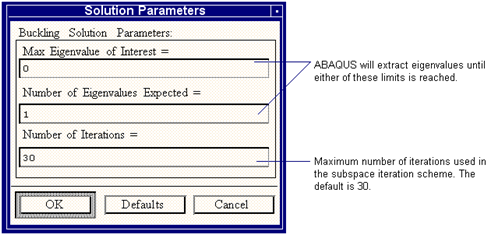
Parameter Name | Description | Output Variable Identifier |
Stress Components | The stress components output depend on the elements analyzed. For example, the truss element outputs the axial stress (S11) only, while a three-dimensional solid element outputs all six components (S11, S22, S33, S12, S13, S23). Note that ABAQUS always reports the Cauchy, or true stress, which is equal to the force per current area. For more information about element output, see Chapter 3 of the ABAQUS/Standard User’s Manual. | S11, S22, S33, S12, S13, S23 |
Stress Invariants | The stress invariants output by ABAQUS are the Mises stress, Tresca stress, Hydrostatic pressure, first principal stress, second principal stress, third principal stress, and the third stress invariant. These quantities are scalar quantities which do not vary with a change of coordinate system. For elastic analyses, the von Mises and/or the Tresca stress invariants can be monitored to ensure that the analysis remains within the assumptions of linearity. | SINV |
Strain Components | This is the total strain value for each component output. The strain components output depend on the elements analyzed, analogous to the stress components. Note that, for linear elastic analyses, the total strain is equal to the elastic strain. | E |
Section Forces | Section forces are output for beam elements and include the axial force, and, as applicable, the shears, bending moments and bimoment about the local axes. These are discussed in Section 3.5.1 and Section 7.5.2 of the ABAQUS/Standard User’s Manual. For shell elements, the section forces include the direct membrane, shear, and moment forces per unit width, as applicable. These are discussed in Section 3.6 of the ABAQUS/Standard User’s Manual. | SF |
Section Strains | Section strains are output for beam elements and, as applicable, these include the axial strain, transverse shear strains, curvature changes, and twist about the local axes.These are discussed in Section 3.5.1 and Sectiono 7.5.2 of the ABAQUS/Standard User’s Manual. For shell elements, the section strains include the direct membrane, shear, curvature changes, and twist, as applicable. These are discussed in Section 3.6 of the ABAQUS/Standard User’s Manual. | SE |
Shell Thickness | Changes in thickness for shell elements (S3RF, S4RF,SAX1, SAX2, SAXA1N, SAXA2N). | STH |
Displacements | Displacements are output at nodes and are referred to as follows: 1. x-displacement 2. y-displacement 3. z-displacement 4. Rotation about the x-axis 5. Rotation about the y-axis 6. Rotation about the z-axis except for axisymmetric elements, where the displacement and rotation degrees-of-freedom are: 1. r-displacement 2. z-displacement 3. Rotation in the r-z plane Here x, y, z, and r are global directions unless a coordinate transformation is used at the node. Note that the warping degree-of-freedom, the seventh displacement component of an open section beam element, is not supported by Patran at this time. | U |
Reaction Forces | The forces at the nodes which are constrained and therefore, resist changes in the system. The direction convention is the same as that for nodal output. | RF |
Element Mass Matrix | Mass matrices output. | |
Element Stiffness Matrix | Stiffness matrices output. |
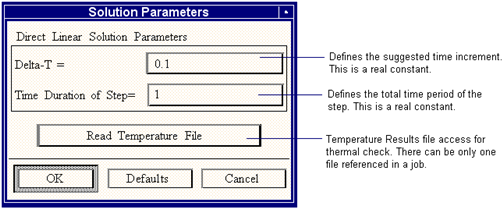
Parameter Name | Description | Output Variable Identifier |
Stress Components | The stress components output depend on the elements analyzed. For example, the truss element outputs the axial stress (S11) only, while a three-dimensional solid element outputs all six components (S11, S22, S33, S12, S13, S23). Note that ABAQUS always reports the Cauchy, or true stress, which is equal to the force per current area. For more information about element output, see Chapter 3 of the ABAQUS/Standard User’s Manual. | S11, S22, S33, S12, S13, S23 |
Stress Invariants | The stress invariants output by ABAQUS are the Mises stress, Tresca stress, Hydrostatic pressure, first principal stress, second principal stress, third principal stress, and the third stress invariant. These quantities are scalar quantities which do not vary with a change of coordinate system. For elastic analyses, the von Mises and/or the Tresca stress invariants can be monitored to ensure that the analysis remains within the assumptions of linearity. | SINV |
Strain Components | This is the total strain value for each component output. The strain components output depend on the elements analyzed, analogous to the stress components. Note that for linear elastic analyses, the total strain is equal to the elastic strain. | E |
Elem Energy Densities | The strain energy per unit volume of each element. | ENER |
Elem Energy Magnitudes | The strain energy of each element. | ELEN |
Internal Stress Forces | The forces that are found at each node by summing the element stress contributions at the nodes. | NFORC |
Section Forces | Section forces are output for beam elements and include the axial force, and, as applicable, the shears, bending moments and bimoment about the local axes. These are discussed in Section 3.5.1 and Section 7.5.2 of the ABAQUS/Standard User’s Manual. For shell elements, the section forces include the direct membrane, shear, and moment forces per unit width, as applicable. These are discussed in Section 3.6 of the ABAQUS/Standard User’s Manual. | SF |
Section Strains | Section strains are output for beam elements and, as applicable, these include the axial strain, transverse shear strains, curvature changes, and twist about the local axes.These are discussed in Section 3.5.1 and Section 7.5.2 of the ABAQUS/Standard User’s Manual. For shell elements, the section strains include the direct membrane, shear, curvature changes, and twist, as applicable. These are discussed in Section 3.6 of the ABAQUS/Standard User’s Manual. | SE |
Shell Thickness | Changes in thickness for shell elements (S3RF, S4RF,SAX1, SAX2, SAXA1N, SAXA2N). | STH |
Displacements | Displacements are output at nodes and are referred to as follows: 1. x-displacement 2. y-displacement 3. z-displacement 4. Rotation about the x-axis 5. Rotation about the y-axis 6. Rotation about the z-axis Except for axisymmetric elements, where the displacement and rotation degrees-of-freedom are: 1. r-displacement 2. z-displacement 3. Rotation in the r-z plane Here x, y, z, and r are global directions unless a coordinate transformation is used at the node. Note that the warping degree-of-freedom, the seventh displacement component of an open section beam element, is not supported by Patran at this time. | U |
Velocities | Nodal velocities, following the same convention as for displacements. | V |
Accelerations | Nodal accelerations, following the same convention as for displacements. | A |
Reaction Forces | The forces at the nodes which are constrained and therefore, resist changes in the system. The direction convention is the same as that for nodal output. | RF |
Point Forces | The forces at the nodes resulting from the imposed loads (e.g., the force at a node resulting from pressure distributions on adjacent elements). | CF |
Whole Model Energies | The summation of all the energy of the model. The kinetic, recoverable (elastic) strain, plastic dissipation, creep dissipation, and viscous dissipation are reported. | ALLEN |
Element Mass Matrix | Mass matrices output. | |
Element Stiffness Matrix | Stiffness matrices output. |
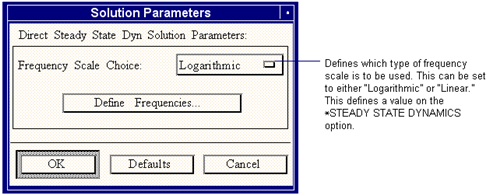
Parameter Name | Description | Output Variable Identifier |
Stress Components | The stress components output depend on the elements analyzed. For example, the truss element outputs the axial stress (S11) only, while a three-dimensional solid element outputs all six components (S11, S22, S33, S12, S13, S23). Note that ABAQUS always reports the Cauchy, or true stress, which is equal to the force per current area. For more information about element output, see Chapter 3 of the ABAQUS/Standard User’s Manual. | S11, S22, S33, S12, S13, S23 |
Stress Invariants | The stress invariants output by ABAQUS are the Mises stress, Tresca stress, Hydrostatic pressure, first principal stress, second principal stress, third principal stress, and the third stress invariant. These quantities are scalar quantities which do not vary with a change of coordinate system. For elastic analyses, the von Mises and/or the Tresca stress invariants can be monitored to ensure that the analysis remains within the assumptions of linearity. | SINV |
Ph Angle Stress Components | The phase angle shift of the stress components. | PHS |
Strain Components | This is the total strain value for each component output. The strain components output depend on the elements analyzed, analogous to the stress components. Note that, for linear elastic analyses, the total strain is equal to the elastic strain. | E |
Ph Angle Strain Components | The phase angle shift of the strain components. | PHE |
Section Forces | Section forces are output for beam elements and include the axial force, and, as applicable, the shears, bending moments and bimoment about the local axes. These are discussed in Section 3.5.1 and Section 7.5.2 of the ABAQUS/Standard User’s Manual. For shell elements, the section forces include the direct membrane, shear, and moment forces per unit width, as applicable. These are discussed in Section 3.6 of the ABAQUS/Standard User’s Manual. | SF |
Section Strains | Section strains are output for beam elements and, as applicable, these include the axial strain, transverse shear strains, curvature changes, and twist about the local axes.These are discussed in Section 3.5.1 and Section 7.5.2 of the ABAQUS/Standard User’s Manual. For shell elements, the section strains include the direct membrane, shear, curvature changes, and twist, as applicable. These are discussed in Section 3.6 of the ABAQUS/Standard User’s Manual. | SE |
Shell Thickness | Changes in thickness for shell elements (S3RF, S4RF,SAX1, SAX2, SAXA1N, SAXA2N). | STH |
Displacements | Displacements are output at nodes and are referred to as follows: 1. x-displacement 2. y-displacement 3. z-displacement 4. Rotation about the x-axis 5. Rotation about the y-axis 6. Rotation about the z-axis except for axisymmetric elements, where the displacement and rotation degrees-of-freedom are: 1. r-displacement 2. z-displacement 3. Rotation in the r-z plane Here x, y, z, and r are global directions unless a coordinate transformation is used at the node. Note that the warping degree-of-freedom, the seventh displacement component of an open section beam element, is not supported by Patran at this time. | U |
Velocities | Nodal velocities, following the same convention as for displacements. | V |
Accelerations | Nodal accelerations, following the same convention as for displacements. | A |
Phase Angle Rel. Displacements | The phase angle shift of the relative displacement components. | PU |
Reaction Forces | The forces at the nodes which are constrained and therefore, resist changes in the system. The direction convention is the same as that for nodal output. | RF |
Phase Angle Reaction Forces | The phase angle shift of the reaction force components. | PRF |
Point Forces | The forces at the nodes resulting from the imposed loads (e.g., the force at a node resulting from pressure distributions on adjacent elements). | CF |
Element Mass Matrix | Mass matrices output. | |
Element Stiffness Matrix | Stiffness matrices output. |
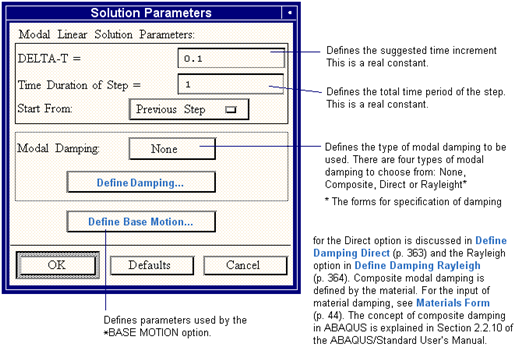
Parameter Name | Description | Output Variable Identifier |
Stress Components | The stress components output depend on the elements analyzed. For example, the truss element outputs the axial stress (S11) only, while a three-dimensional solid element outputs all six components (S11, S22, S33, S12, S13, S23). Note that ABAQUS always reports the Cauchy, or true stress, which is equal to the force per current area. For more information about element output, see Chapter 3 of the ABAQUS/Standard User’s Manual. | S11, S22, S33, S12, S13, S23 |
Stress Invariants | The stress invariants output by ABAQUS are the Mises stress, Tresca stress, Hydrostatic pressure, first principal stress, second principal stress, third principal tress, and the third stress invariant. These quantities are scalar quantities which do not vary with a change of coordinate system. For elastic analyses, the von Mises and/or the Tresca stress invariants can be monitored to ensure that the analysis remains within the assumptions of linearity. | SINV |
Strain Components | This is the total strain value for each component output. The strain components output depend on the elements analyzed, analogous to the stress components. Note that for linear elastic analyses, the total strain is equal to the elastic strain. | E |
Section Forces | Section forces are output for beam elements and include the axial force, and, as applicable, the shears, bending moments and bimoment about the local axes. These are discussed in Section 3.5.1 and Section 7.5.2 of the ABAQUS/Standard User’s Manual. For shell elements, the section forces include the direct membrane, shear, and moment forces per unit width, as applicable. These are discussed in Section 3.6 of the ABAQUS/Standard User’s Manual. | SF |
Section Strains | Section strains are output for beam elements and, as applicable, these include the axial strain, transverse shear strains, curvature changes, and twist about the local axes.These are discussed in Section 3.5.1 and Section 7.5.2 of the ABAQUS/Standard User’s Manual. For shell elements, the section strains include the direct membrane, shear, curvature changes, and twist, as applicable. These are discussed in Section 3.6 of the ABAQUS/Standard User’s Manual. | SE |
Shell Thickness | Changes in thickness for shell elements (S3RF, S4RF,SAX1, SAX2, SAXA1N, SAXA2N) | STH |
Displacements | Displacements are output at nodes and are referred to as follows: 1. x-displacement 2. y-displacement 3. z-displacement 4. Rotation about the x-axis 5. Rotation about the y-axis 6. Rotation about the z-axis Except for axisymmetric elements, where the displacement and rotation degrees-of-freedom are: 1. r-displacement 2. z-displacement 3. Rotation in the r-z plane Here x, y, z, and r are global directions unless a coordinate transformation is used at the node. Note that the warping degree-of-freedom, the seventh displacement component of an open section beam element, is not supported by Patran at this time. | U |
Velocities | Nodal velocities, following the same convention as for displacements. | V |
Acceleration | Nodal accelerations, following the same convention as for displacements. | A |
Total Displacements | The summation of all individual modal components of displacement. The output follows the same convention as for the individual modal components. | TU |
Total Velocities | The summation of all individual modal components of velocity. The output follows the same convention as for the individual modal components. | TV |
Total Accelerations | The summation of all individual modal components of acceleration. The output follows the same convention as for the individual modal components. | TA |
Reaction Forces | The forces at the nodes which are constrained and therefore, resist changes in the system. The direction convention is the same as that for nodal output. | RF |
Point Forces | The forces at the nodes resulting from the imposed loads, (e.g., the force at a node resulting from pressure distributions on adjacent elements). | CF |
Generalized Displacements | The displacements associated with the modes of vibrations, each of which have a shape (eigenmode) and associated frequency (eigenvalue). | GU |
Generalized Velocities | The velocities associated with the modes of vibration. | GV |
Generalized Accelerations | The accelerations associated with the modes of vibration. | GA |
Strain Energy per Mode | Elastic strain energy for the entire model per each mode. | SNE |
Kinetic Energy per Mode | Kinetic energy for the entire model per each mode. | KE |
External Work per Mode | External work for the entire model per each mode. | T |
Base Motion | The base motion (displacement, velocity, or acceleration). | BM |
Whole Model Energies | The summation of all the energy of the model. The kinetic, recoverable (elastic) strain, plastic dissipation, creep dissipation, and viscous dissipation are reported. | ALLEN |
Element Mass Matrix | Mass matrices output. | |
Element Stiffness Matrix | Stiffness matrices output. |
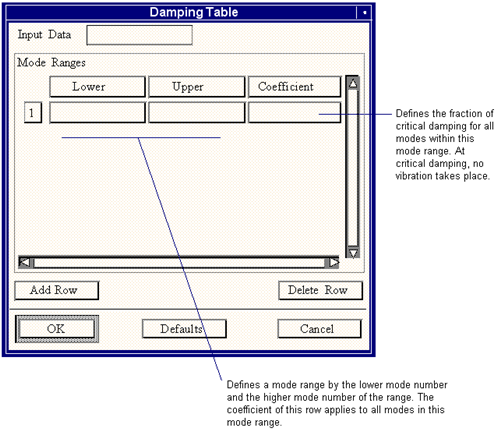
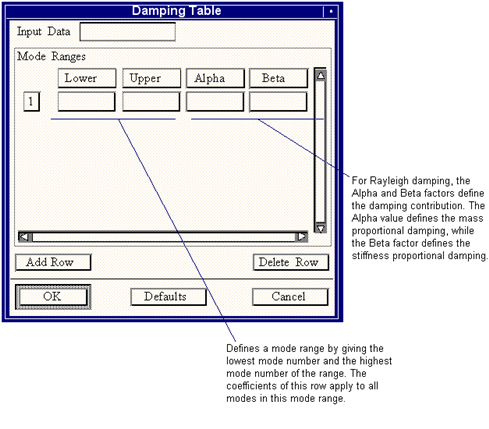
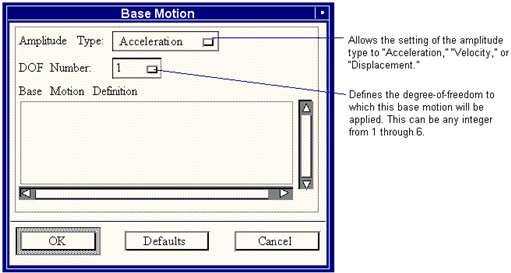
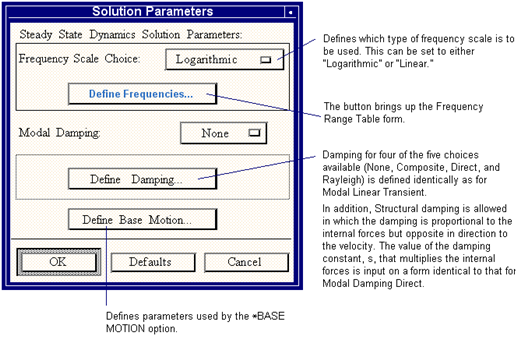
Parameter Name | Description | Output Variable Identifier |
Stress Components | The stress components output depend on the elements analyzed. For example, the truss element outputs the axial stress (S11) only, while a three-dimensional solid element outputs all six components (S11, S22, S33, S12, S13, S23). Note that ABAQUS always reports the Cauchy, or true stress, which is equal to the force per current area. For more information about element output, see Chapter 3 of the ABAQUS/Standard User’s Manual. | S11, S22, S33, S12, S13, S23 |
Ph Angle Stress Component | The phase angle shift of the stress components. | PHS |
Stress Invariants | The stress invariants output by ABAQUS are the Mises stress, Tresca stress, Hydrostatic pressure, first principal stress, second principal stress, third principal stress, and the third stress invariant. These quantities are scalar quantities which do not vary with a change of coordinate system. For elastic analyses, the von Mises and/or the Tresca stress invariants can be monitored to ensure that the analysis remains within the assumptions of linearity. | SINV |
Strain Components | This is the total strain value for each component output. The strain components output depend on the elements analyzed, analogous to the stress components. Note that for linear elastic analyses, the total strain is equal to the elastic strain. | E |
Ph Angle Strain Component | The phase angle shift of the strain components. | PHE |
Element Energy Magnitudes | A scalar value for the energy content of the element. | ELEN |
Section Forces | Section forces are output for beam elements and include the axial force, and, as applicable, the shears, bending moments and bimoment about the local axes. These are discussed in Section 3.5.1 and Section 7.5.2 of the ABAQUS/Standard User’s Manual. For shell elements, the section forces include the direct membrane, shear, and moment forces per unit width, as applicable. These are discussed in Section 3.6 of the ABAQUS/Standard User’s Manual. | SF |
Section Strains | Section strains are output for beam elements and, as applicable, these include the axial strain, transverse shear strains, curvature changes, and twist about the local axes.These are discussed in Section 3.5.1 and Section 7.5.2 of the ABAQUS/Standard User’s Manual. For shell elements, the section strains include the direct membrane, shear, curvature changes, and twist, as applicable. These are discussed in Section 3.6 of the ABAQUS/Standard User’s Manual. | SE |
Shell Thickness | Changes in thickness for shell elements (S3RF, S4RF,SAX1, SAX2, SAXA1N, SAXA2N). | STH |
Displacements | Displacements are output at nodes and are referred to as follows: 1. x-displacement 2. y-displacement 3. z-displacement 4. Rotation about the x-axis 5. Rotation about the y-axis 6. Rotation about the z-axis Except for axisymmetric elements, where the displacement and rotation degrees-of-freedom are: 1. r-displacement 2. z-displacement 3. Rotation in the r-z plane Here x, y, z, and r are global directions unless a coordinate transformation is used at the node. Note that the warping degree-of-freedom, the seventh displacement component of an open section beam element, is not supported by Patran at this time. | U |
Velocities | Nodal velocities, following the same convention as for displacements. | V |
Accelerations | Nodal accelerations, following the same convention as for displacements. | A |
Total Displacements | The summation of all individual modal components of displacement. The output follows the same convention as for the individual modal components. | TU |
Total Velocities | The summation of all individual modal components of velocity. The output follows the same convention as for the individual modal components. | TV |
Total Accelerations | The summation of all individual modal components of acceleration. The output follows the same convention as for the individual modal components. | TA |
Phase Angle Rel. Displacements | All components of the phase angle of the displacements at the node. | PU |
Phase Angle Total Displacements | All components of the phase angle of the total displacements at the node. | PTU |
Reaction Forces | The forces at the nodes which are constrained and so, therefore, resist changes in the system. The direction convention is the same as that for nodal output. | RF |
Phase Angle Reaction Forces | All components of the phase angle of the reaction forces at the node. | PRF |
Point Forces | The forces at the nodes resulting from the imposed loads, (e.g., the force at a node resulting from pressure distributions on adjacent elements). | CF |
Generalized Displacements | The displacements associated with the modes of vibrations, each of which have a shape (eigenmode) and associated frequency (eigenvalue). | GU |
Generalized Velocities | The velocities associated with the modes of vibration. | GV |
Generalized Accelerations | The accelerations associated with the modes of vibration. | GA |
Phase Angle Generalized Displacements | The phase angle of displacements associated with the modes of vibrations, each of which have a shape (eigenmode) and associated frequency (eigenvalue). | PGU |
Phase Angle Generalized Velocities | The phase angle of velocities associated with the modes of vibration. | PGV |
Phase Angle Generalized Accelerations | The phase angle of accelerations associated with the modes of vibration. | PGA |
Strain Energy per Mode | Elastic strain energy for the entire model per each mode. | SNE |
Kinetic Energy per Mode | Kinetic energy for the entire model per each mode. | KE |
External Work per Mode | External work for the entire model per each mode. | T |
Base Motion | The base motion (displacement, velocity, or acceleration). | BM |
Whole Model Energies | The summation of all the energy of the model. The kinetic, recoverable (elastic) strain, plastic dissipation, creep dissipation, and viscous dissipation are reported. | ALLEN |
Element Mass Matrix | Mass matrices output. | |
Element Stiffness Matrix | Stiffness matrices output. |
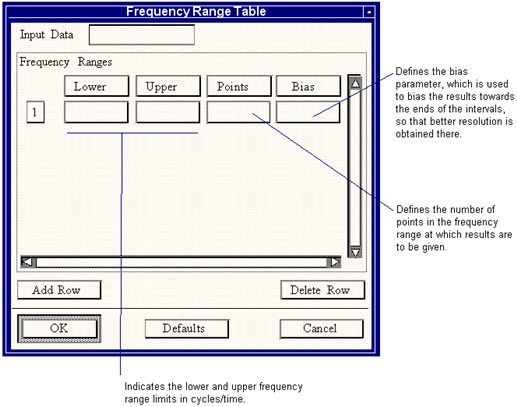
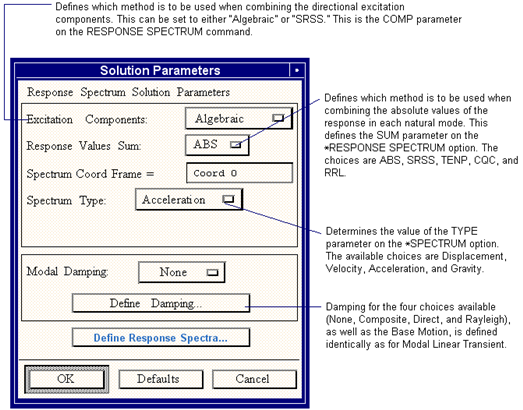
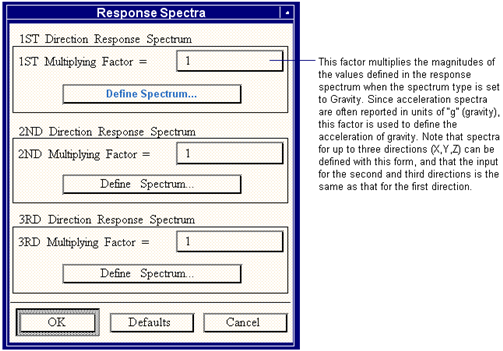
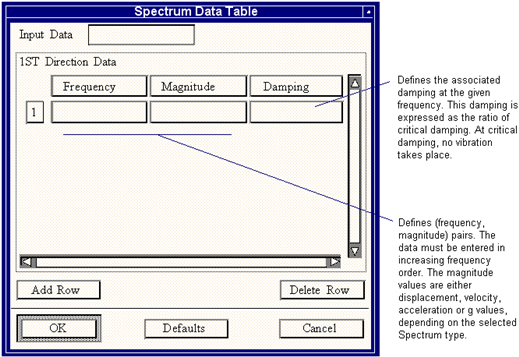
Parameter Name | Description | Output Variable Identifier |
Stress Components | The stress components output depend on the elements analyzed. For example, the truss element outputs the axial stress (S11) only, while a three-dimensional solid element outputs all six components (S11, S22, S33, S12, S13, S23). Note that ABAQUS always reports the Cauchy, or true stress, which is equal to the force per current area. For more information about element output, see Chapter 3 of the ABAQUS/Standard User’s Manual. | S11, S22, S33, S12, S13, S23 |
Stress Invariants | The stress invariants output by ABAQUS are the Mises stress, Tresca stress, Hydrostatic pressure, first principal stress, second principal stress, third principal stress, and the third stress invariant. These quantities are scalar quantities which do not vary with a change of coordinate system. For elastic analyses, the von Mises and/or the Tresca stress invariants can be monitored to ensure that the analysis remains within the assumptions of linearity. | SINV |
Strain Components | This is the total strain value for each component output. The strain components output depend on the elements analyzed, analogous to the stress components. Note that for linear elastic analyses, the total strain is equal to the elastic strain. | E |
Section Forces | Section forces are output for beam elements and include the axial force, and, as applicable, the shears, bending moments and bimoment about the local axes. These are discussed in Section 3.5.1 and Section 7.5.2 of the ABAQUS/Standard User’s Manual. For shell elements, the section forces include the direct membrane, shear, and moment forces per unit width, as applicable. These are discussed in Section 3.6 of the ABAQUS/Standard User’s Manual. | SF |
Section Strains | Section strains are output for beam elements and, as applicable, these include the axial strain, transverse shear strains, curvature changes, and twist about the local axes.These are discussed in Section 3.5.1 and Section 7.5.2 of the ABAQUS/Standard User’s Manual. For shell elements, the section strains include the direct membrane, shear, curvature changes, and twist, as applicable. These are discussed in Section 3.6 of the ABAQUS/Standard User’s Manual. | SE |
Shell Thickness | Changes in thickness for shell elements (S3RF, S4RF,SAX1, SAX2, SAXA1N, SAXA2N). | STH |
Displacements | Displacements are output at nodes and are referred to as follows: 1. x-displacement 2. y-displacement 3. z-displacement 4. Rotation about the x-axis 5. Rotation about the y-axis 6. Rotation about the z-axis Except for axisymmetric elements, where the displacement and rotation degrees-of-freedom are: 1. r-displacement 2. z-displacement 3. Rotation in the r-z plane Here x, y, z, and r are global directions unless a coordinate transformation is used at the node. Note that the warping degree-of-freedom, the seventh displacement component of an open section beam element, is not supported by Patran at this time. | U |
Velocities | Nodal velocities, following the same convention as for displacements. | V |
Accelerations | Nodal accelerations, following the same convention as for displacements. | A |
Reaction Forces | The forces at the nodes which are constrained and therefore, resist changes in the system. The direction convention is the same as that for nodal output. | RF |
Point Forces | The forces at the nodes resulting from the imposed loads (e.g., the force at a node resulting from pressure distributions on adjacent elements). | CF |
Generalized Displacements | The displacements associated with the modes of vibrations, each of which have a shape (eigenmode) and associated frequency (eigenvalue). | GU |
Generalized Velocities | The velocities associated with the modes of vibration. | GV |
Generalized Accelerations | The accelerations associated with the modes of vibration. | GA |
Strain Energy per Mode | Elastic strain energy for the entire model per each mode. | SNE |
Kinetic Energy per Mode | Kinetic energy for the entire model per each mode. | KE |
External Work per Mode | External work for the entire model per each mode. | T |
Base Motion | The base motion (displacement, velocity, or acceleration). | BM |
Whole Model Energies | The summation of all the energy of the model. The kinetic, recoverable (elastic) strain, plastic dissipation, creep dissipation, and viscous dissipation are reported. | ALLEN |
Element Mass Matrix | Mass matrices output. | |
Element Stiffness Matrix | Stiffness matrices output. |
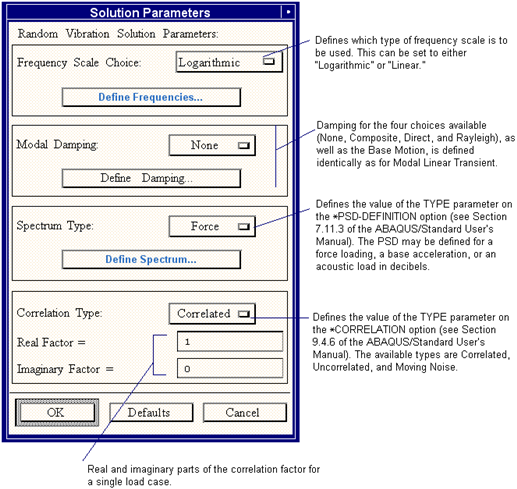
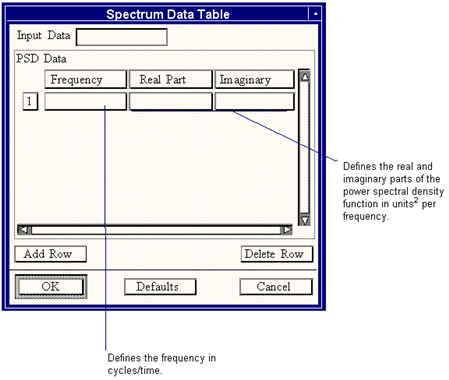
Parameter Name | Description | Output Variable Identifier |
Stress Components | The stress components output depend on the elements analyzed. For example, the truss element outputs the axial stress (S11) only, while a three-dimensional solid element outputs all six components (S11, S22, S33, S12, S13, S23). Note that ABAQUS always reports the Cauchy, or true stress, which is equal to the force per current area. For more information about element output, see Chapter 3 of the ABAQUS/Standard User’s Manual. | S11, S22, S33, S12, S13, S23 |
R.M.S. Stress Components | The root mean square value of the stress components. | RA |
Stress Invariants | The stress invariants output by ABAQUS are the Mises stress, Tresca stress, Hydrostatic pressure, first principal stress, second principal stress, third principal stress, and the third stress invariant. These quantities are scalar quantities which do not vary with a change of coordinate system. For elastic analyses, the von Mises and/or the Tresca stress invariants can be monitored to ensure that the analysis remains within the assumptions of linearity. | SINV |
Strain Components | This is the total strain value for each component output. The strain components output depend on the elements analyzed, analogous to the stress components. Note that for linear elastic analyses, the total strain is equal to the elastic strain. | E |
R.M.S. Strain Components | The root mean square value of the strain components. | RE |
Section Forces | Section forces are output for beam elements and include the axial force, and, as applicable, the shears, bending moments and bimoment about the local axes. These are discussed in Section 3.5.1 and Section 7.5.2 of the ABAQUS/Standard User’s Manual. For shell elements, the section forces include the direct membrane, shear, and moment forces per unit width, as applicable. These are discussed in Section 3.6 of the ABAQUS/Standard User’s Manual. | SF |
Section Strains | Section strains are output for beam elements and, as applicable, these include the axial strain, transverse shear strains, curvature changes, and twist about the local axes.These are discussed in Section 3.5.1 and Section 7.5.2 of the ABAQUS/Standard User’s Manual. For shell elements, the section strains include the direct membrane, shear, curvature changes, and twist, as applicable. These are discussed in Section 3.6 of the ABAQUS/Standard User’s Manual. | SE |
Shell Thickness | Changes in thickness for shell elements (S3RF, S4RF,SAX1, SAX2, SAXA1N, SAXA2N). | STH |
Displacements | Displacements are output at nodes and are referred to as follows: 1. x-displacement 2. y-displacement 3. z-displacement 4. Rotation about the x-axis 5. Rotation about the y-axis 6. Rotation about the z-axis Except for axisymmetric elements, where the displacement and rotation degrees-of-freedom are: 1. r-displacement 2. z-displacement 3. Rotation in the r-z plane Here x, y, z, and r are global directions unless a coordinate transformation is used at the node. Note that the warping degree-of-freedom, the seventh displacement component of an open section beam element, is not supported by Patran at this time. | U |
Velocities | Nodal velocities, following the same convention as for displacements. | V |
Accelerations | Nodal accelerations, following the same convention as for displacements. | A |
R.M.S. Relative Displacement | The root mean square value of the displacement components relative to the base motion. | RU |
R.M.S. Relative Velocities | The root mean square value of the velocity components relative to the base motion. | RV |
R.M.S. Relative Acceleration | The root mean square value of the acceleration components relative to the base motion. | RA |
Total Displacements | The total displacement (including base motion) of the nodes. | TU |
Total Velocities | The total velocity (including base motion) of the nodes. | TV |
Total Acceleration | The total acceleration (including base motion) of the nodes. | TA |
R.M.S. Total Displacements | The root mean square value of the displacement components including the base motion. | RTU |
R.M.S. Total Velocities | The root mean square value of the velocity components including the base motion. | RTV |
R.M.S. Total Accelerations | The root mean square value of the acceleration components including the base motion. | RTA |
Reaction Forces | The forces at the nodes which are constrained and therefore, resist changes in the system. The direction convention is the same as that for nodal output. | RF |
R.M.S. Reaction Forces | The root mean square value of the modal component of the reaction forces. | RRF |
Point Forces | The forces at the nodes resulting from the imposed loads (e.g., the force at a node resulting from pressure distributions on adjacent elements). | CF |
Generalized Displacements | The displacements associated with the modes of vibrations, each of which have a shape (eigenmode) and associated frequency (eigenvalue). | GU |
Generalized Velocities | The velocities associated with the modes of vibrations, each of which have a shape (eigenmode) and associated frequency (eigenvalue). | GV |
Generalized Accelerations | The accelerations associated with the modes of vibrations, each of which have a shape (eigenmode) and associated frequency (eigenvalue). | GA |
Base Motion | The base motion (displacement, velocity, or acceleration). | BM |
Whole Model Energies | The summation of all the energy of the model. The kinetic, recoverable (elastic) strain, plastic dissipation, creep dissipation, and viscous dissipation is reported. | ALLEN |
Element Mass Matrix | Mass matrices output. | |
Element Stiffness Matrix | Stiffness matrices output. |
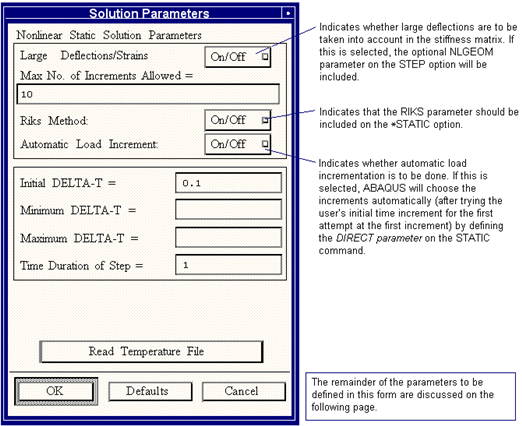
Parameter Name | Description |
Max No of Increments | Defines the maximum number of increments that can be used within a single step. This is a positive integer value. This is the optional INC parameter on the ∗STEP option. |
Initial DELTA-T | Defines the initial time increment to be used. This is a real constant. This will be modified as required if the automatic time stepping scheme is used. Otherwise, it will be used as a constant time increment. |
Minimum DELTA-T | Defines the minimum time increment to be used. This is a real constant. It is only used for automatic time incrementation. If ABAQUS finds it needs a smaller time increment than this value, the analysis is terminated. |
Maximum DELTA-T | Defines the maximum time increment to be used. This is a real constant. It is only used for automatic time incrementation. If this value is not specified, no upper limit is imposed. |
Time Duration of Step | Defines the total time period of the step. This is a real constant. |
Parameter Name | Description |
Initial Load Fraction | Defines the initial load fraction to be applied to the model. This is a real constant. This is the initial time increment data value on the ∗STATIC command. |
Minimum Load Fraction | Defines the minimum load fraction which will be added during any increment. These are real constants. |
Maximum Load Fraction | Defines the maximum load fraction which will be added during any increment. These are real constants. |
Stopping Condition | Indicates which stopping condition is to be used. This can be set to “Max. no. increments”, “Max. load multiplier”, or “Monitor a Node.” This indicates which stopping condition data values are to be defined on the ∗STATIC option. |
Max. Load Multiplier | This defines the maximum load multiplier allowed before the iteration will be stopped. This is only used if “Max. load multiplier,” or “Monitor a Node” are selected. |
Node Number | Indicates the node ID to be monitored. This is only used if “Monitor a Node” is selected. |
Limit Value | Defines the limiting displacement at the node being monitored. This is only used if “Monitor a Node” is selected. |
DOF Number | Indicates which degree-of-freedom at this node is to be monitored. This is only used if “Monitor a Node” is selected. |
Parameter Name | Description | Output Variable Identifier |
Stress Components | The stress components output depend on the elements analyzed. For example, the truss element outputs the axial stress (S11) only, while a three-dimensional solid element outputs all six components (S11, S22, S33, S12, S13, S23). Note that ABAQUS always reports the Cauchy, or true stress, which is equal to the force per current area. For more information about element output, see Chapter 3 of the ABAQUS/Standard User’s Manual. | S11, S22, S33, S12, S13, S23 |
Stress Invariants | The stress invariants output by ABAQUS are the Mises stress, Tresca stress, Hydrostatic pressure, first principal stress, second principal stress, third principal stress, and the third stress invariant. These quantities are scalar quantities which do not vary with a change of coordinate system. For elastic analyses, the von Mises and/or the Tresca stress invariants can be monitored to ensure that the analysis remains within the assumptions of linearity. | SINV |
Strain Components | This is the total strain value for each component output. The strain components output depend on the elements analyzed, analogous to the stress components. Note that for linear elastic analyses, the total strain is equal to the elastic strain. | E |
Plastic Strains | The plastic strain component of the total strain. | PE |
Creep Strains | The creep strain component of the total strain. | CE |
Elastic Strains | The elastic strain component of the total strain. Note that the elastic strain component is the component from which the stress is computed. | EE |
Inelastic Strains | The total strain minus the elastic strain component. | IE |
Elem Energy Densities | The energy per unit volume of each element. Strain, plastic, creep, and viscous dissipative energy densities are reported. | ENER |
Elem Energy Magnitudes | The energy of each element. Strain, kinetic, plastic, creep, and viscous dissipative energies are reported. | ELEN |
Internal Stress Forces | The forces that are found at each node by summing the element stress contributions at the nodes. | NFORC |
Section Forces | Section forces are output for beam elements and include the axial force, and, as applicable, the shears, bending moments and bimoment about the local axes. These are discussed in Section 3.5.1 and Section 7.5.2 of the ABAQUS/Standard User’s Manual. For shell elements, the section forces include the direct membrane, shear, and moment forces per unit width, as applicable. These are discussed in Section 3.6 of the ABAQUS/Standard User’s Manual. | SF |
Section Strains | Section strains are output for beam elements and, as applicable, these include the axial strain, transverse shear strains, curvature changes, and twist about the local axes.These are discussed in Section 3.5.1 and Section 7.5.2 of the ABAQUS/Standard User’s Manual. For shell elements, the section strains include the direct membrane, shear, curvature changes, and twist, as applicable. These are discussed in Section 3.6 of the ABAQUS/Standard User’s Manual. | SE |
Shell Thickness | Changes in thickness for shell elements (S3RF, S4RF,SAX1, SAX2, SAXA1N, SAXA2N). | STH |
Displacement | Displacements are output at nodes and are referred to as follows: 1. x-displacement 2. y-displacement 3. z-displacement 4. Rotation about the x-axis 5. Rotation about the y-axis 6. Rotation about the z-axis Except for axisymmetric elements, where the displacement and rotation degrees-of-freedom are: 1. r-displacement 2. z-displacement 3. Rotation in the r-z plane Here x, y, z, and r are global directions unless a coordinate transformation is used at the node. Note that the warping degree-of-freedom, the seventh displacement component of an open section beam element, is not supported by Patran at this time. | U |
Reaction Forces | The forces at the nodes which are constrained and therefore, resist changes in the system. The direction convention is the same as that for nodal output. | RF |
Point Forces | The forces at the nodes resulting from the imposed loads (e.g., the force at a node resulting from pressure distributions on adjacent elements). | CF |
Whole Model Energies | The summation of all the energy of the model. The kinetic, recoverable (elastic) strain, plastic dissipation, creep dissipation, and viscous dissipation is reported. | ALLEN |
Element Mass Matrix | Mass matrices output. | |
Element Stiffness Matrix | Stiffness matrices output. |
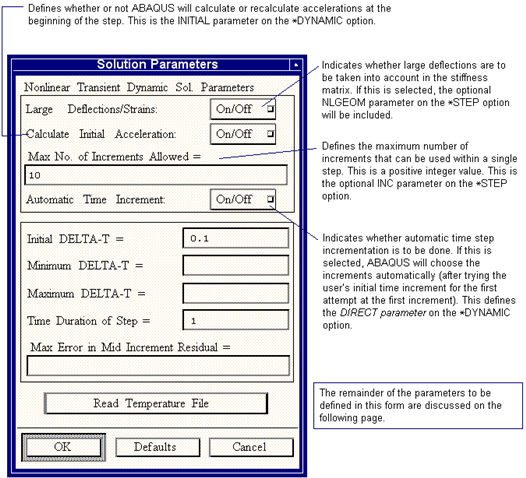
Parameter Name | Description |
Initial DELTA-T | Defines the initial time increment to be used. This is a real constant. This will be modified as required if the automatic time stepping scheme is used. Otherwise, it will be used as a constant time increment. |
Minimum DELTA-T | Defines the minimum time increment to be used. This is a real constant. It is only used for automatic time incrementation. If ABAQUS finds it needs a smaller time increment than this value, the analysis is terminated. |
Maximum DELTA-T | Defines the maximum time increment to be used. This is a real constant. It is only used for automatic time incrementation. If this value is not specified, no upper limit is imposed. |
Time Duration of Step | Defines the total time period of the step. This is a real constant. |
Max Error in Mid Increment Residual | This is the HAFTOL parameter on the ∗DYNAMIC option. See Section 9.3.4 of the ABAQUS/Standard User’s Manual and Section 5.2.1 of the ABAQUS/Standard Example Problems. |
Parameter Name | Description | Output Variable Identifier |
Stress Components | The stress components output depend on the elements analyzed. For example, the truss element outputs the axial stress (S11) only, while a three-dimensional solid element outputs all six components (S11, S22, S33, S12, S13, S23). Note that ABAQUS always reports the Cauchy, or true stress, which is equal to the force per current area. For more information about element output, see Chapter 3 of the ABAQUS/Standard User’s Manual. | S11, S22, S33, S12, S13, S23 |
Stress Invariants | The stress invariants output by ABAQUS are the Mises stress, Tresca stress, Hydrostatic pressure, first principal stress, second principal stress, third principal stress, and the third stress invariant. These quantities are scalar quantities which do not vary with a change of coordinate system. For elastic analyses, the von Mises and/or the Tresca stress invariants can be monitored to ensure that the analysis remains within the assumptions of linearity. | SINV |
Strain Components | This is the total strain value for each component output. The strain components output depend on the elements analyzed, analogous to the stress components. Note that, for linear elastic analyses, the total strain is equal to the elastic strain. | E |
Plastic Strains | The plastic strain component of the total strain. | PE |
Creep Strains | The creep strain component of the total strain. | CE |
Elastic Strains | The elastic strain component of the total strain. Note that the elastic strain component is the component from which the stress is computed. | EE |
Inelastic Strains | The total strain minus the elastic strain component. | IE |
Elem Energy Densities | The energy per unit volume of each element. Strain, plastic, creep, and viscous dissipative energy densities are reported. | ENER |
Elem Energy Magnitudes | The energy of each element. Strain, kinetic, elastic, creep, and viscous dissipative energies are reported. | ELEM |
Internal Stress Forces | The forces that are found at each node by summing the element stress contributions at the nodes. | NFORC |
Section Forces | Section forces are output for beam elements and include the axial force, and, as applicable, the shears, bending moments and bimoment about the local axes. These are discussed in Section 3.5.1 and Section 7.5.2 of the ABAQUS/Standard User’s Manual. For shell elements, the section forces include the direct membrane, shear, and moment forces per unit width, as applicable. These are discussed in Section 3.6 of the ABAQUS/Standard User’s Manual. | SF |
Section Strains | Section strains are output for beam elements and, as applicable, these include the axial strain, transverse shear strains, curvature changes, and twist about the local axes.These are discussed in Section 3.5.1 and Section 7.5.2 of the ABAQUS/Standard User’s Manual. For shell elements, the section strains include the direct membrane, shear, curvature changes, and twist, as applicable. These are discussed in Section 3.6 of the ABAQUS/Standard User’s Manual. | SW |
Shell Thickness | Changes in thickness for shell elements (S3RF, S4RF,SAX1, SAX2, SAXA1N, SAXA2N). | STH |
Displacements | Displacements are output at nodes and are referred to as follows: 1. x-displacement 2. y-displacement 3. z-displacement 4. Rotation about the x-axis 5. Rotation about the y-axis 6. Rotation about the z-axis Except for axisymmetric elements, where the displacement and rotation degrees-of-freedom are: 1. r-displacement 2. z-displacement 3. Rotation in the r-z plane Here x, y, z, and r are global directions unless a coordinate transformation is used at the node. Note that the warping degree-of-freedom, the seventh displacement component of an open section beam element, is not supported by Patran at this time. | U |
Velocities | Nodal velocities, following the same convention as for displacements. | V |
Accelerations | Nodal accelerations, following the same convention as for displacements. | A |
Reaction Forces | The forces at the nodes which are constrained and therefore, resist changes in the system. The direction convention is the same as that for nodal output. | RF |
Point Forces | The forces at the nodes resulting from the imposed loads (e.g., the force at a node resulting from pressure distributions on adjacent elements). | CF |
Whole Model Energies | The summation of all the energy of the model. The kinetic, recoverable (elastic) strain, plastic dissipation, creep dissipation, and viscous dissipation is reported. | ALLEN |
Element Mass Matrix | Mass matrices output. | |
Element Stiffness Matrix | Stiffness matrices output. |
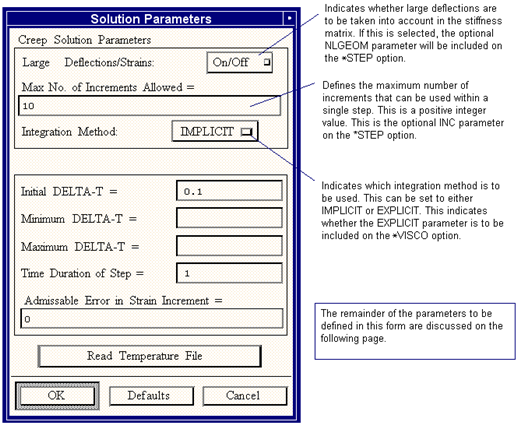
Parameter Name | Description |
Initial DELTA-T | Defines the initial time increment to be used. This is a real constant. This will be modified as required if the automatic time stepping scheme is used. Otherwise, it will be used as a constant time increment. |
Minimum DELTA-T | Defines the minimum time increment to be used. This is a real constant. It is only used for automatic time incrementation. If ABAQUS finds it needs a smaller time increment than this value, the analysis is terminated. |
Maximum DELTA-T | Defines the maximum time increment to be used. This is a real constant. It is only used for automatic time incrementation. If this value is not specified, no upper limit is imposed. |
Time Duration of Step | Defines the total time period of the step. This is a real constant. |
Admissable Error in Strain Increment | This is the CETOL parameter on the ∗VISCO option. See Section 9.3.15 of the ABAQUS/Standard User’s Manual. |
Parameter Name | Description | Output Variable Identifier |
Stress Components | The stress components output depend on the elements analyzed. For example, the truss element outputs the axial stress (S11) only, while a three-dimensional solid element outputs all six components (S11, S22, S33, S12, S13, S23). Note that ABAQUS always reports the Cauchy, or true stress, which is equal to the force per current area. For more information about element output, see Chapter 3 of the ABAQUS/Standard User’s Manual. | S11, S22, S33, S12, S13, S23 |
Stress Invariants | The stress invariants output by ABAQUS are the Mises stress, Tresca stress, Hydrostatic pressure, first principal stress, second principal stress, third principal stress, and the third stress invariant. These quantities are scalar quantities which do not vary with a change of coordinate system. For elastic analyses, the von Mises and/or the Tresca stress invariants can be monitored to ensure that the analysis remains within the assumptions of linearity. | SINV |
Strain Components | This is the total strain value for each component output. The strain components output depend on the elements analyzed, analogous to the stress components. Note that for linear elastic analyses, the total strain is equal to the elastic strain. | E |
Plastic Strains | The plastic strain component of the total strain. | PE |
Creep Strains | The creep strain component of the total strain. | CE |
Elastic Strains | The elastic strain component of the total strain. Note that the elastic strain component is the component from which the stress is computed. | EE |
Inelastic Strains | The total strain minus the elastic strain component. | IE |
Elem Energy Densities | The energy per unit volume of each element. Strain, plastic, creep, and viscous dissipative energy densities are reported. | ENER |
Elem Energy Magnitudes | The energy of each element. Strain, kinetic, elastic, creep, and viscous dissipative energies are reported. | ELEM |
Internal Stress Forces | The forces that are found at each node by summing the element stress contributions at the nodes. | NFORC |
Section Forces | Section forces are output for beam elements and include the axial force, and, as applicable, the shears, bending moments and bimoment about the local axes. These are discussed in Section 3.5.1 and Section 7.5.2 of the ABAQUS/Standard User’s Manual. For shell elements, the section forces include the direct membrane, shear, and moment forces per unit width, as applicable. These are discussed in Section 3.6 of the ABAQUS/Standard User’s Manual. | SF |
Section Strains | Section strains are output for beam elements and, as applicable, these include the axial strain, transverse shear strains, curvature changes, and twist about the local axes.These are discussed in Section 3.5.1 and Section 7.5.2 of the ABAQUS/Standard User’s Manual. For shell elements, the section strains include the direct membrane, shear, curvature changes, and twist, as applicable. These are discussed in Section 3.6 of the ABAQUS/Standard User’s Manual. | SE |
Shell Thickness | Changes in thickness for shell elements (S3RF, S4RF,SAX1, SAX2, SAXA1N, SAXA2N). | STH |
Displacements | Displacements are output at nodes and are referred to as follows: 1. x-displacement 2. y-displacement 3. z-displacement 4. Rotation about the x-axis 5. Rotation about the y-axis 6. Rotation about the z-axis Except for axisymmetric elements, where the displacement and rotation degrees-of-freedom are: 1. r-displacement 2. z-displacement 3. Rotation in the r-z plane Here x, y, z, and r are global directions unless a coordinate transformation is used at the node. Note that the warping degree-of-freedom, the seventh displacement component of an open section beam element, is not supported by Patran at this time. | U |
Reaction Forces | The forces at the nodes which are constrained and therefore, resist changes in the system. The direction convention is the same as that for nodal output. | RF |
Point Forces | The forces at the nodes resulting from the imposed loads (e.g., the force at a node resulting from pressure distributions on adjacent elements). | CF |
Whole Model Energies | The summation of all the energy of the model. The kinetic, recoverable (elastic) strain, plastic dissipation, creep dissipation, and viscous dissipation are reported. | ALLEN |
Element Mass Matrix | Mass matrices output. | |
Element Stiffness Matrix | Stiffness matrices output. |
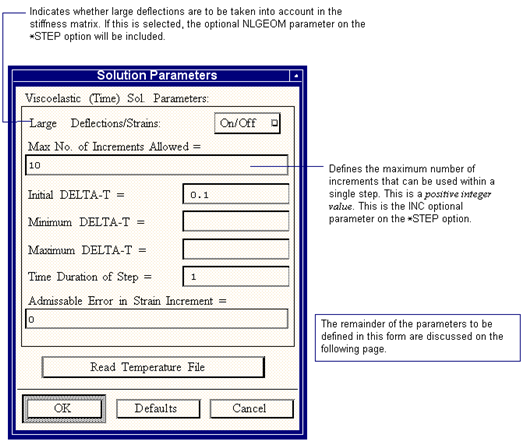
Parameter Name | Description |
Initial DELTA-T | Defines the initial time increment to be used. This is a real constant. This will be modified as required if the automatic time stepping scheme is used. Otherwise, it will be used as a constant time increment. |
Minimum DELTA-T | Defines the minimum time increment to be used. This is a real constant. It is only used for automatic time incrementation. If ABAQUS finds it needs a smaller time increment than this value, the analysis is terminated. |
Maximum DELTA-T | Defines the maximum time increment to be used. This is a real constant. It is only used for automatic time incrementation. If this value is not specified, no upper limit is imposed. |
Time Duration of Step | Defines the total time period of the step. This is a real constant. |
Parameter Name | Description | Output Variable Identifier |
Stress Components | The stress components output depend on the elements analyzed. For example, the truss element outputs the axial stress (S11) only, while a three-dimensional solid element outputs all six components (S11, S22, S33, S12, S13, S23). Note that ABAQUS always reports the Cauchy, or true stress, which is equal to the force per current area. For more information about element output, see Chapter 3 of the ABAQUS/Standard User’s Manual. | S11, S22, S33, S12, S13, S23 |
Stress Invariants | The stress invariants output by ABAQUS are the Mises stress, Tresca stress, Hydrostatic pressure, first principal stress, second principal stress, third principal stress, and the third stress invariant. These quantities are scalar quantities which do not vary with a change of coordinate system. For elastic analyses, the von Mises and/or the Tresca stress invariants can be monitored to ensure that the analysis remains within the assumptions of linearity. | SINV |
Strain Components | This is the total strain value for each component output. The strain components output depend on the elements analyzed, analogous to the stress components. Note that for linear elastic analyses, the total strain is equal to the elastic strain. | E |
Plastic Strains | The plastic strain component of the total strain. | PE |
Creep Strains | The creep strain component of the total strain. | CE |
Elastic Strains | The elastic strain component of the total strain. Note that the elastic strain component is the component from which the stress is computed. | EE |
Inelastic Strains | The total strain minus the elastic strain component. | IE |
Elem Energy Densities | The energy per unit volume of each element. Strain, plastic, creep, and viscous dissipative energy densities are reported. | ENER |
Elem Energy Magnitudes | The energy of each element. Strain, kinetic, elastic, creep, and viscous dissipative energies are reported. | ELEM |
Internal Stress Forces | The forces that are found at each node by summing the element stress contributions at the nodes. | NFORC |
Section Forces | Section forces are output for beam elements and include the axial force, and, as applicable, the shears, bending moments and bimoment about the local axes. These are discussed in Section 3.5.1 and Section 7.5.2 of the ABAQUS/Standard User’s Manual. For shell elements, the section forces include the direct membrane, shear, and moment forces per unit width, as applicable. These are discussed in Section 3.6 of the ABAQUS/Standard User’s Manual. | SF |
Section Strains | Section strains are output for beam elements and, as applicable, these include the axial strain, transverse shear strains, curvature changes, and twist about the local axes.These are discussed in Section 3.5.1 and Section 7.5.2 of the ABAQUS/Standard User’s Manual. For shell elements, the section strains include the direct membrane, shear, curvature changes, and twist, as applicable. These are discussed in Section 3.6 of the ABAQUS/Standard User’s Manual. | SE |
Shell Thickness | Changes in thickness for shell elements (S3RF, S4RF,SAX1, SAX2, SAXA1N, SAXA2N). | STH |
Displacements | Displacements are output at nodes and are referred to as follows: 1. x-displacement 2. y-displacement 3. z-displacement 4. Rotation about the x-axis 5. Rotation about the y-axis 6. Rotation about the z-axis Except for axisymmetric elements, where the displacement and rotation degrees-of-freedom are: 1. r-displacement 2. z-displacement 3. Rotation in the r-z plane Here x, y, z, and r are global directions unless a coordinate transformation is used at the node. Note that the warping degree-of-freedom, the seventh displacement component of an open section beam element, is not supported by Patran at this time. | U |
Reaction Forces | The forces at the nodes which are constrained and therefore, resist changes in the system. The direction convention is the same as that for nodal output. | RF |
Point Forces | The forces at the nodes resulting from the imposed loads (e.g., the force at a node resulting from pressure distributions on adjacent elements). | CF |
Whole Model Energies | The summation of all the energy of the model. The kinetic, recoverable (elastic) strain, plastic dissipation, creep dissipation, and viscous dissipation is reported. | ALLEN |
Element Mass Matrix | Mass matrices output. | |
Element Stiffness Matrix | Stiffness matrices output. |
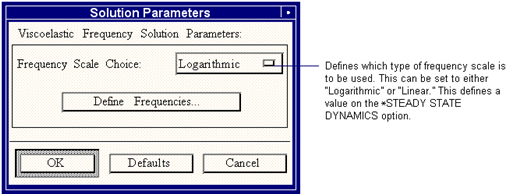
Parameter Name | Description | Output Variable Identifier |
Stress Components | The stress components output depend on the elements analyzed. For example, the truss element outputs the axial stress (S11) only, while a three-dimensional solid element outputs all six components (S11, S22, S33, S12, S13, S23). Note that ABAQUS always reports the Cauchy, or true stress, which is equal to the force per current area. For more information about element output, see Chapter 3 of the ABAQUS/Standard User’s Manual. | S11, S22, S33, S12, S13, S23 |
Stress Invariants | The stress invariants output by ABAQUS are the Mises stress, Tresca stress, Hydrostatic pressure, first principal stress, second principal stress, third principal stress, and the third stress invariant. These quantities are scalar quantities which do not vary with a change of coordinate system. For elastic analyses, the von Mises and/or the Tresca stress invariants can be monitored to ensure that the analysis remains within the assumptions of linearity. | SINV |
Ph Angle Stress Components | The phase angle shift of the stress components. | PHS |
Strain Components | This is the total strain value for each component output. The strain components output depend on the elements analyzed, analogous to the stress components. Note that, for linear elastic analyses, the total strain is equal to the elastic strain. | E |
Ph Angle Strain Components | The phase angle shift of the strain components. | PHE |
Section Forces | Section forces are output for beam elements and include the axial force, and, as applicable, the shears, bending moments and bimoment about the local axes. These are discussed in Section 3.5.1 and Section 7.5.2 of the ABAQUS/Standard User’s Manual. For shell elements, the section forces include the direct membrane, shear, and moment forces per unit width, as applicable. These are discussed in Section 3.6 of the ABAQUS/Standard User’s Manual. | SF |
Section Strains | Section strains are output for beam elements and, as applicable, these include the axial strain, transverse shear strains, curvature changes, and twist about the local axes.These are discussed in Section 3.5.1 and Section 7.5.2 of the ABAQUS/Standard User’s Manual. For shell elements, the section strains include the direct membrane, shear, curvature changes, and twist, as applicable. These are discussed in Section 3.6 of the ABAQUS/Standard User’s Manual. | SE |
Shell Thickness | Changes in thickness for shell elements (S3RF, S4RF,SAX1, SAX2, SAXA1N, SAXA2N). | STH |
Displacements | Displacements are output at nodes and are referred to as follows: 1. x-displacement 2. y-displacement 3. z-displacement 4. Rotation about the x-axis 5. Rotation about the y-axis 6. Rotation about the z-axis Except for axisymmetric elements, where the displacement and rotation degrees-of-freedom are: 1. r-displacement 2. z-displacement 3. Rotation in the r-z plane Here x, y, z, and r are global directions unless a coordinate transformation is used at the node. Note that the warping degree-of-freedom, the seventh displacement component of an open section beam element, is not supported by Patran at this time. | U |
Velocities | Nodal velocities, following the same convention as for displacements. | V |
Accelerations | Nodal accelerations, following the same convention as for displacements. | A |
Phase Angle Rel. Displacements | The phase angle shift of the relative displacement components. | PU |
Reaction Forces | The forces at the nodes which are constrained and so, therefore, resist changes in the system. The direction convention is the same as that for nodal output. | RF |
Phase Angle Reaction Forces | The phase angle shift of the reaction force components. | PRF |
Point Forces | The forces at the nodes resulting from the imposed loads (e.g., the force at a node resulting from pressure distributions on adjacent elements). | CF |
Element Mass Matrix | Mass matrices output. | |
Element Stiffness Matrix | Stiffness matrices output. |
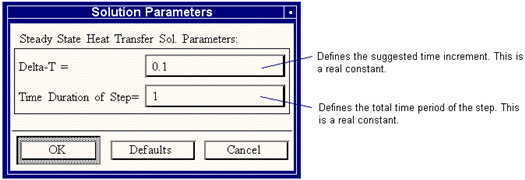
Parameter Name | Description | Output Variable Identifier |
Element Temperature | Temperature. | TEMP |
Heat Flux | Current magnitude and components of the heat flux vector. The integration of points for these values are located at the Gauss points. | HFL |
Nodal Temperatures | All temperature values at a node. These will be the temperatures defined as degrees-of-freedom if heat transfer elements are connected to the node, or predefined temperatures if the node is only connected to stress elements without temperature degrees-of-freedom. | NT |
Reaction Fluxes | All reaction flux values (conjugate to temperature). | RFL |
Concentrated Fluxes | All concentrated flux values. | CFL |
Element Stiffness Matrix | Stiffness matrices output. |
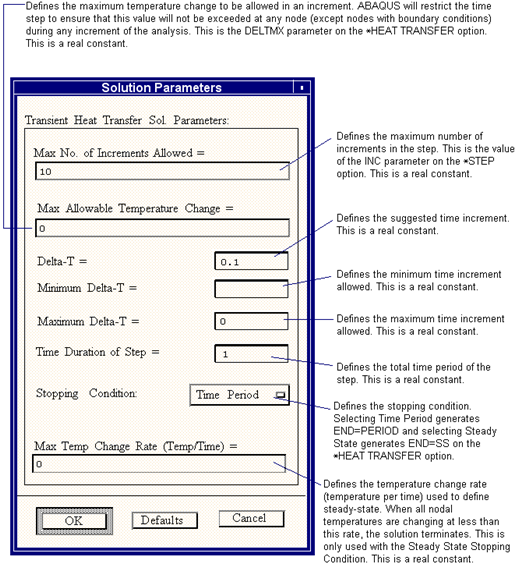
Parameter Name | Description | Output Variable Identifier |
Element Temperature | Temperature. | TEMP |
Heat Flux | Current magnitude and components of the heat flux vector. The integration of points for these values are located at the Gauss points. | HFL |
Nodal Temperatures | All temperature values at a node. These will be the temperatures defined as degrees-of-freedom if heat transfer elements are connected to the node, or predefined temperatures if the node is only connected to stress elements without temperature degrees-of-freedom. | NT |
Reaction Fluxes | All reaction flux values (conjugate to temperature). | RFL |
Concentrated Fluxes | All concentrated flux values. | CFL |
Element Stiffness Matrix | Stiffness matrices output. |